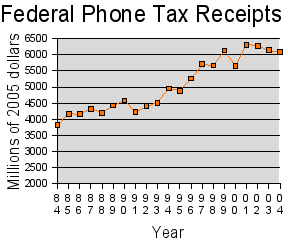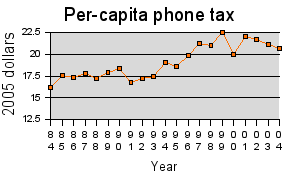The Spanish-American War Tax survived that war to become the federal excise tax that hides among so many other obscure fees on our monthly phone bills today. It is a favorite target of war tax resisters — both because of its history as a war tax and because resisting it is relatively easy and risk-free. For many tax resisters, phone tax resistance was the first step they took before they moved on to the harder stuff.
The tax has shown surprising endurance, but is starting to show its age. There are frequent repeal attempts — in Congress passed a spending bill that included a repeal of the tax but President Clinton vetoed it; new legislation is targeting it for repeal again.
If Congress hasn’t been able to get rid of this “temporary” tax for , I won’t hold my breath. But I may not have to — the phone tax is starting to decay in the face of modern communication technology without much help from the politicians.
The internet is part of this. Today a lot of communication that used to happen over telephone is taking place in email and instant-messenger conversations and the like. Also, the internet is starting to become a useful mechanism for voice communication — behaving like a phone, but not being billed or taxed like a phone.
The tax law is not keeping up with this, although the usual suspects in government are doing what they can to try to tax and regulate these new communications methods as they emerge.
Another way in which the phone tax is failing to keep up with the times is the “flat-rate long-distance” loophole (see also: ). The law authorizing the federal excise tax on long distance reads in part:
(b) Toll telephone service
For purposes of this subchapter, the term “toll telephone service“ means—(1) a telephonic quality communication for which (A) there is a toll charge which varies in amount with the distance and elapsed transmission time of each individual communication and (B) the charge is paid within the United States…
Some long distance companies have a plan that charges per call, but does not vary that charge by the distance of the call. In other words, you’re charged by the minute, but can call anywhere in the United States at the same rate.
A few clients of these companies objected to paying the excise tax because the law says that in order to be taxed under the law I quoted above a service must have “a toll charge which varies in amount with the distance and elapsed transmission time of each individual communication.”
The IRS argued in court that by “and” it really meant “and/or” but most courts disagreed (one court agreed, but that decision recently got shot down on appeal).
If you’ve got one of these sorts of long distance plans, here’s the advice from one corporate law firm:
Consumers of long distance telephone service should consider filing claims with the IRS seeking refund of taxes paid on toll telephone service. At this point, it is not known whether the IRS will change its refund policy in light of the recent court of appeals decision, but even if the IRS chooses to “stick to its guns” and continues to deny refund claims, seeking refund and being denied is a necessary condition precedent to going to court to challenge the IRS denial.
The right to refund is not unlimited. There is a three year statute of limitations on refund claims with the IRS. Thus, taxpayers may not claim refunds for Federal Excise Tax paid before (assuming that refund claims are filed immediately). Also, IRS refund procedures require that claims be thoroughly documented. Records of payments — preferably photocopies of invoices — must be attached to any refund claims. For companies who have not saved their telephone bill records for the past three years, it is possible that your vendors will be able to provide copies of bills to you.
But I wondered: What effect is all of this having on how much money the government is getting? I took the federal excise tax receipts numbers for from the (new and improved) IRS Tax Stats page and filtered them through the government’s consumer-price-index data to adjust the values for inflation. ( is when the current 3% excise tax rate took hold.) Here’s what I came up with:

I don’t know that I’ve got it in me to draw much in the way of conclusions from that, but it satisfies my curiosity a bit. A few more years of that downward slide in and I’ll go ahead and call it a trend, but the over-all gist is clearly larger tax receipts as time goes on. I suspect that this is largely the result of population growth, and suddenly start to wonder how the graph would look if I adjusted it further to show per-capita tax receipts:

Turns out it flattens the graph a bit, but doesn’t make a lot of difference to the trends shown. Oh well…
For more information on phone tax resistance, see and . For a debate on whether it is worth the bother, see and . For more on how the phone tax is and isn’t adjusting to modern telecommunications, see , and .
